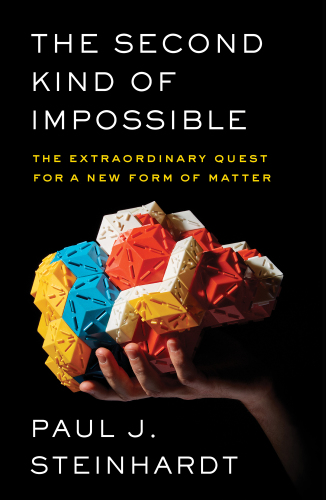
The Second Kind of Impossible
The Extraordinary Quest for a New Form of Matter
کتاب های مرتبط
- اطلاعات
- نقد و بررسی
- دیدگاه کاربران
نقد و بررسی

October 8, 2018
In an intriguing blend of science and international adventure, Steinhardt (Endless Universe, coauthor), a Princeton professor of physics and astrophysics, takes readers on a wild ride in search of a new kind of matter. The author’s hunt for a rare crystal structure once thought impossible begins in the early 1980s, when he proposed the existence of “quasicrystals” with a unique property called “five-fold symmetry.” Months of making paper models and Styrofoam-and-pipe cleaner “arts-and-craft” projects showed how minerals might form such crystals, and despite scoffing from luminaries such as Nobel laureate Linus Pauling, one scientist managed to grow a quasicrystal in 1987. But could quasicrystals exist in nature? The quest takes Steinhardt from Princeton University to Florence, Italy, and ultimately to a remote mountain range in the rugged, bear- and mosquito-infested wilds of Russia’s Kamchatka Peninsula. The author’s opening discussion of crystallography basics, “cubatic matter,” and Penrose tiling demands close attention, but the second half of the book is full of intrigue and adventure, culminating with the epic Kamchatka journey. As a result, a general audience can and should enjoy this original, suspenseful true-life thriller of science investigation and discovery. Agent: Katinka Matson, Brockman.

October 15, 2018
An admirable popular account of the quasicrystal, an oddball arrangement of atoms that seems to contradict scientific laws.Steinhardt (Physics and Astrophysical Sciences/Princeton Univ.; co-author: Endless Universe: Beyond the Big Bang, 2006), a pioneer in the field and a fine writer, makes a mighty effort to describe a complex chemical phenomenon; he mostly succeeds. Readers should carefully read his explanation of how pure substances such as minerals form periodic, symmetric arrangements of atoms called crystals, which must fit together with no gaps into which other atoms can squeeze. Only three forms qualify: the tetrahedron, the triangular prism, and the parallelepiped (six-sided box). Popular writers use the tiling analogy. To install a bathroom floor, only square, triangular, or hexagonal tiles fit perfectly. Just as you can't fit pentagonal or octagonal tiles into the floor, no crystal can have five or eight or any larger-sided symmetry. This was the rule--not really a formal law--until Roger Penrose invented Penrose tiles in the 1970s. These can fill any room despite having bizarre shapes. Intrigued, scientists began producing five, eight, and other many-sided "quasicrystals" by heating and rapidly cooling metals in the laboratory. Thankfully, Steinhardt turns his attention from crystal theory to chronicle a gripping scientific quest. He and his colleagues searched the world's mineralogical collections, drawing a blank until minuscule specks from Italy showed promise. Proof required finding similar pieces in a natural location, an exhaustive 10-year process that began with frustrating detective work to discover the specimen's source, followed by an expedition to Siberia and success in 2009. Scientists figured out that natural quasicrystals form through temperatures and pressures that don't exist on Earth; they're found in meteorite fragments.The research continues, and it will hopefully produce technological marvels (or maybe not). Meanwhile, readers will enjoy this enthusiastic introduction to a weird but genuine new form of matter.
COPYRIGHT(2018) Kirkus Reviews, ALL RIGHTS RESERVED.

December 1, 2018
In his latest work, Steinhardt (Albert Einstein Professor in Science, Princeton Univ.; coauthor, Endless Universe) does a masterful job of making a complex subject more accessible by detailing efforts to prove the existence of quasicrystals: structures that are ordered but not periodic. A Caltech graduate, Steinhardt had the honor and challenge of making the case for quasicrystals to physicist Richard Feynman and chemist Linus Pauling. Here, working alongside his colleagues and graduate students, the author recounts all of their efforts to study the matter. Using conversational analogies to Dungeons & Dragons and Penrose tiling, this narrative covers the journey of a scientist, from successes to seemingly dead ends, as well as the author's own travels to find naturally occurring quasicrystals. VERDICT This is a rather atypical popular physics book for college and adult readers, with its focus on crystallography rather than astrophysics. The quest-filled narrative along with the author's casual style create an extremely readable work that gives insight into the work involved in scientific discovery.--Sara R. Tompson, Jet Propulsion Laboratory Lib., Pasadena, CA
Copyright 2018 Library Journal, LLC Used with permission.

























دیدگاه کاربران